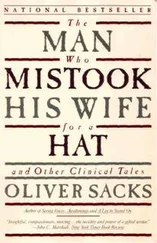A patient of Hoeflmayr’s saw words written in the air; a patient of Schob’s had hallucinations of letters, words, and numbers; and a patient reported by Fuller et al. “saw writing on the wall and when asked what it was said he was too far from it. He then walked up to the wall and was able to read it out clearly.”
Lilliputian hallucinations can occur in migraine (as well as in other conditions), as Siri Hustvedt described in a New York Times blog:
I was lying in bed reading a book by Italo Svevo, and for some reason, looked down, and there they were: a small pink man and his pink ox, perhaps six or seven inches high. They were perfectly made creatures and, except for their color, they looked very real . They didn’t speak to me, but they walked around, and I watched them with fascination and a kind of amiable tenderness. They stayed for some minutes and then disappeared. I have often wished they would return, but they never have.
All of these effects seem to show, by default, what a colossal and complicated achievement normal vision is, as the brain constructs a visual world in which color and movement and size and form and stability are all seamlessly meshed and integrated. I came to regard my own migraine experiences as a sort of spontaneous (and fortunately reversible) experiment of nature, a window into the nervous system — and I think this was one reason I decided to become a neurologist.
What is stirring up the visual system during a migraine attack, to provoke such hallucinations? William Gowers, writing more than a century ago, when little was known of the cellular details of the visual cortex (or the brain’s electrical activity), addressed this question in The Border-land of Epilepsy:
The process which gives rise to the sensory symptoms … of migraine is very mysterious.… There is a peculiar form of activity which seems to spread, like the ripples in a pond into which a stone is thrown. But the activity is slow, deliberate, occupying twenty minutes or so in passing through the centre affected. In the region through which the active ripple waves have passed, a state is left like molecular disturbance of the structures.
Gowers’s intuition proved quite accurate and was given physiological backing decades later, when it was discovered that a wave of electrical excitation could track across the cerebral cortex at much the same rate the fortifications did. In 1971, Whitman Richards suggested that the zigzag shape of migraine fortification patterns, with its characteristic angles, might reflect something equally constant in the architecture of the visual cortex itself — perhaps clusters of the orientation-sensitive neurons which Hubel and Wiesel had demonstrated in the early 1960s. As the wave of electrical excitation slowly marches across the cortex, Richards suggested, it might directly stimulate these clusters, causing the patient to “see” shimmering bars of light at different angles. But it was only with the use of magnetoencephalography, twenty years later, that it was possible to demonstrate that the passage of fortifications in a migraine aura was indeed accompanied by just such a wave of electrical excitation.
A hundred and fifty years ago, the astronomer Hubert Airy (who was a migraineur himself) felt that the aura of migraine provided “a sort of photograph” of the brain in action. He, like Gowers, may have been more literally accurate than he knew.
Heinrich Klüver, writing about mescal, remarked that the simple geometric hallucinations one might get with hallucinogenic drugs were identical to those found in migraine and many other conditions. Such geometrical forms, he felt, were not dependent on memory or personal experience or desire or imagination; they were built into the very architecture of the brain’s visual systems.
But while the zigzag fortification patterns are highly stereotyped and can perhaps be understood in terms of the orientation receptors in the primary visual cortex, a different sort of explanation must be sought for the rapidly changing, permuting play of geometric forms. Here we need dynamic explanations, a consideration of the ways in which the activity of millions of nerve cells can produce complex and ever-changing patterns. We can actually see, through such hallucinations, something of the dynamics of a large population of living nerve cells and, in particular, the role of self-organization in allowing complex patterns of activity to emerge. Such activity operates at a basic cellular level, far beneath the level of personal experience. The hallucinatory forms are, in this way, physiological universals of human experience.
Perhaps such experiences are at the root of our human obsession with pattern and the fact that geometrical patterns find their way into our decorative arts. As a child, I was fascinated by the patterns in our house — the square colored floor tiles on the front porch, the small hexagonal ones in the kitchen, the herringbone pattern on the curtains in my room, the check pattern on my father’s suit. When I was taken to the synagogue for services, I was more interested in the mosaics of tiny tiles on the floor than in the religious liturgy. And I loved the pair of antique Chinese cabinets in our drawing room, for embossed on their lacquered surfaces were designs of wonderful intricacy on different scales, patterns nested within patterns, all surrounded by clusters of tendrils and leaves. These geometric and scrolling motifs seemed somehow familiar to me, though it did not dawn on me until years later that this was because I had seen them in my own head, that these patterns resonated with my own inner experience of the intricate tilings and swirls of migraine.
Migraine-like patterns, indeed, can be found in Islamic art, in classical and medieval motifs, in Zapotec architecture, in the bark paintings of Aboriginal artists in Australia, in Acoma pottery, in Swazi basketry — in virtually every culture, going back tens of thousands of years. There seems to have been, throughout human history, a need to externalize and make art from these internal experiences, from the cross-hatchings of prehistoric cave paintings to the swirling psychedelic art of the 1960s. Do the arabesques and hexagons in our own minds, built into our brain organization, provide us with our first intimations of formal beauty?
There is an increasing feeling among neuroscientists that self-organizing activity in vast populations of visual neurons is a prerequisite of visual perception — that this is how seeing begins. Spontaneous self-organization is not restricted to living systems; one may see it in the formation of snow crystals, in the roilings and eddies of turbulent water, in certain oscillating chemical reactions. Here, too, self-organization can produce geometries and patterns in space and time very similar to what one may see in a migraine aura. In this sense, the geometrical hallucinations of migraine allow us to experience in ourselves not only a universal of neural functioning but a universal of nature itself.
Epilepsy affects a substantial minority of the population, occurs in all cultures, and has been recognized since the dawn of recorded history. It was known to Hippocrates as the sacred disease, a disorder of divine inspiration. 40 40 When Hippocrates wrote “On the Sacred Disease,” he was bowing to the then-popular notion of epilepsy’s divine origin, but he dismisses this in his opening sentence: “The disease called sacred … appears to me no more sacred than other diseases, but has a natural cause from which it originates, like other affections.”
And yet in its major, convulsive form (the only form recognized until the nineteenth century), it has attracted fear, hostility, and cruel discrimination. It still carries a good deal of stigma today.
Читать дальше












